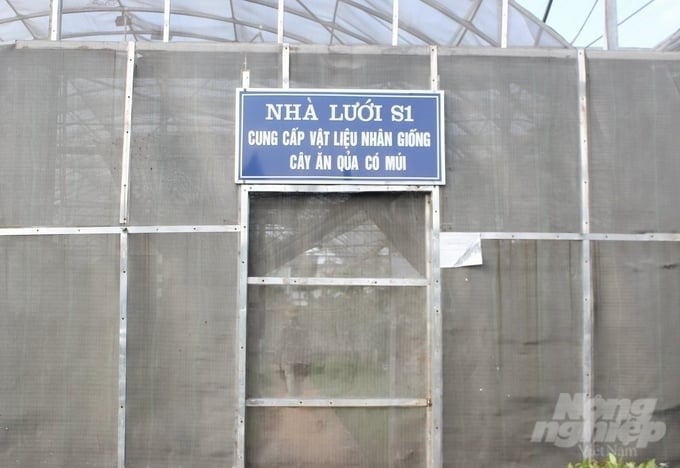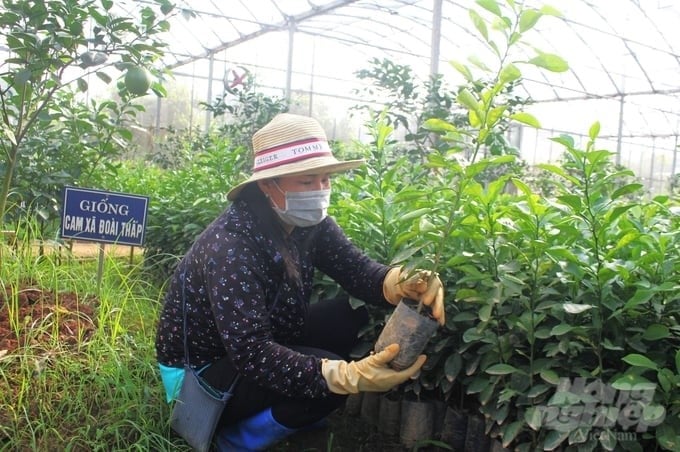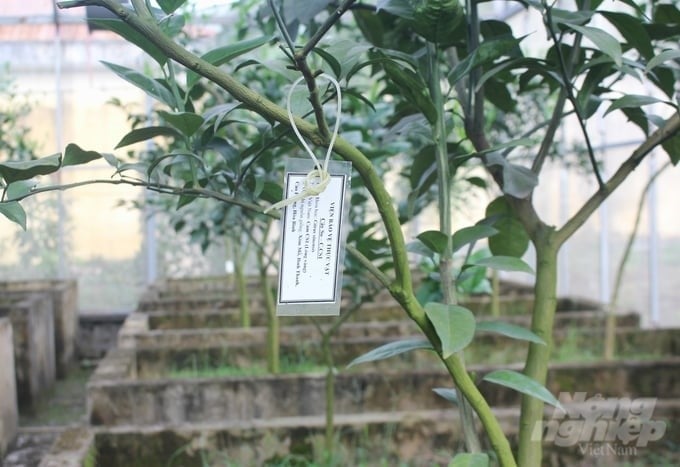May 30, 2025 | 13:39 GMT +7
May 30, 2025 | 13:39 GMT +7
Hotline: 0913.378.918
May 30, 2025 | 13:39 GMT +7
Hotline: 0913.378.918
Cao Phong district is a locality that accounts for approximately 30% of the total citrus tree area of Hoa Binh province, of which orange trees account for more than 50% of the entire province's area. After a period of overheated development, many orange areas that did not meet the requirements for seed sources, farming techniques, pest prevention and control, etc., revealed "death spots", quickly degraded, and did not bring economic efficiency. More dangerous is that the “Cao Phong Orange” brand is gradually fading.

The 3-level breeding net house system of the Hoa Binh Center for Plant, Animal, and Seafood Seeds is ready to provide a disease-free seed source for replanting orange trees in the province. Photo: Trung Quan.
Faced with that reality, the Hoa Binh Provincial People's Committee has directed the Department of Agriculture and Rural Development to coordinate with the Cao Phong District People's Committee to focus on synchronously and effectively implementing the project “Replanting citrus trees in Hoa Binh province for the period 2021–2025, with a vision to 2030”. This project aims to bring Cao Phong orange trees back to their inherent position.
The project has pointed out the basic causes of the degradation of the Cao Phong orange region and solutions to overcome them. The Department of Agriculture and Rural Development also issued a temporary process guiding the replanting of citrus trees in the province, particularly focusing on replanting Cao Phong orange trees.
Mr. Nguyen Hong Yen, Director of the Hoa Binh Sub-Department of Cultivation and Plant Protection, shared that, in addition to solutions on farming techniques, infrastructure, etc., seed work plays a particularly important role as a decisive premise for "changing blood" for the Cao Phong orange region.
The Hoa Binh Department of Agriculture and Rural Development has directed the Hoa Binh Center for Plant, Animal, and Seafood Seeds to effectively operate the 3-level breeding net house system to select quality, disease-free orange varieties for the replanting program.
Besides, continue to select orange varieties that ensure productivity and quality, are consistent with natural conditions in Hoa Binh province, and meet the ratio of orange seed groups of early-ripening at 30%, main season at 40%, and late-ripening at 30%. At the same time, priority is given to selecting orange varieties that have affirmed productivity and quality at the locality, such as CS1 orange, Xa Doai (dwarf variety), V2, Canh orange, etc.

Before leaving the garden, S2 orange seedlings are analyzed and tested for two dangerous diseases, namely greening and Tristera, and root-damaging fungi and nematodes. Photo: Trung Quan.
Mr. Nguyen Van Hung, Director of Hoa Binh Center for Plant, Animal, and Seafood Seeds, shared that the Center has a 3-level breeding net house system that meets national standards and is now storing 100 original seedlings (S0), nearly 500 S1 seedlings, and tens of thousands of S2 seedlings (seedlings put into production).
The process of creating S2 seedlings is carried out completely in a net house and greenhouse system, strictly isolated from the outside environment, and closely monitored at each stage.
Before leaving the garden, S2 plants are analyzed and tested for two dangerous diseases, namely greening and Tristera, as well as root-damaging fungi and nematodes. The seedlings must ensure the factors are within the allowable threshold before being delivered to the grower.
According to Mr. Hung, the Center currently has 30,000 seedlings qualified for leaving the garden, ensuring enough supply for the province's citrus tree replanting program in the period 2021–2025. In addition, 50,000 rootstock trees nurtured by the Center are qualified to carry out grafting. Therefore, in the coming time, the number of S1 trees, the source of materials to produce S2 seedlings, will certainly increase, ensuring enough supply for phase 2 of the province's citrus tree replanting projects and possibly expanding production to serve the needs of quality seedlings in neighboring provinces if there is a need in the future.

To create quality seedlings, the source of the original seeds and rootstock trees must be carefully selected and created. Photo: Trung Quan.
Mr. Hung also wondered that, within the scope of the citrus tree replanting project, participating households will be supported with free seedlings from the Center's 3-level breeding house. However, there are still many difficulties in replicating quality seedlings in all gardens. This is because the entire production process of the S2 orange variety ensuring quality standards is quite strict with high costs, leading to a slightly higher seedling price than the common ground that gardeners are self-producing and selling on the market.
Meanwhile, the sentiment of preferring cheap things makes many households still buy floating seedlings of unknown origin, or even self-produce, exchange, or give each other seeds that have not been tested for quality. This underlies the risk of dangerous disease outbreaks. Therefore, to gradually change people's awareness and farming habits, there must be the participation of the entire political system from province to village in disseminating, mobilizing, and guiding people to approach official information channels and new and effective farming techniques.
"The Center is developing a plan to develop a garden to supply seeds for centralized rootstock trees. From there, it will reduce collection costs and gradually lower the cost of seedlings so that growing households in the province can conveniently access quality seedlings," Mr. Nguyen Van Hung said.
Translated by Huyen Vu Thu
/2025/05/25/4127-3-073637_820.jpg)
(VAN) Thanks to the promotion from an FAO-implemented project, vegetable production in greenhouses in Moc Chau has seen strong development, from 1.5 hectares in 2021 to nearly 50 hectares in 2024.

(VAN) FAO has recently supported USD 140,000 to implement the project 'Risk mitigation human-animal interface risks through disease control initiatives in pig farming.'

(VAN) The People's Committee of Tra Vinh province has approved an adjustment to the investment policy for the Green Hydrogen Plant project, increasing its area to approximately 52.76 hectares.
![Reducing emissions from rice fields: [2] Farmers’ commitment to the soil](https://t.ex-cdn.com/nongnghiepmoitruong.vn/608w/files/news/2025/05/05/dsc08881jpg-nongnghiep-140632.jpg)
(VAN) Clean rice cultivation model in Thuong Tan commune, Bac Tan Uyen district, is assisting local residents in achieving sustainable agriculture by substantially reducing costs, increasing productivity, and protecting the environment.

(VAN) At the conference to disseminate Resolution No. 68, AgriS introduced its digital agricultural ecosystem and reaffirmed its commitment to accompanying the Government in promoting private sector development and sustainable agriculture.

(VAN) 'Blue Ocean - Blue Foods' initiative is designed to restore marine ecosystems and establish sustainable livelihoods for local communities by cultivating a minimum of 1,000 hectares of cottonii seaweed in the first three years.
/2025/05/21/4642-3-112707_603.jpg)
(VAN) The V-SCOPE project has made direct contributions to three out of six pillars of the Comprehensive Strategic Partnership between Vietnam and Australia.